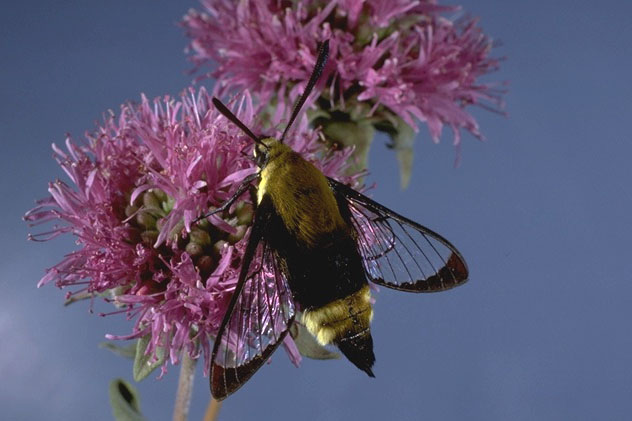
Hemaris thetis, photo courtesy of T.W. Davies.
This site has been created by Bill Oehlke.
Comments, suggestions and/or additional information are welcomed by Bill.
TAXONOMY:
Family: Sphingidae, Latreille, 1802 |

This site has been created by Bill Oehlke.
Comments, suggestions and/or additional information are welcomed by Bill.
TAXONOMY:
Family: Sphingidae, Latreille, 1802 |
Subsequently thetis was synonymized with diffinis, but, based on paper by Christian Schmidt
Journal of the Lepidopterists' Society 63(2), 2009, 100-109. Hemaris thetis (Boisduval, 1855) (Sphingidae), H. thetis in now recognized as a
distinct species, based on DNA and genitalia analysis.
In some places just East of the Divide (Colorado, Alberta) overlap of ranges of H. thetis and H. diffinis is known and precise determinations,
by photographs only, will be next to impossible.
Thanks to Edna Woodward and Ryan St. Laurent for alerting me of this change. It will be a little while before I get the changes made on the Sphingidae of the Americas website.
I will shortly create the H. thetis page and will move all appropriate images off the original H. diffinis page and add them to the new page.Those Sphingidae west of the continental divide (western Montana, Idaho, Washington,
Oregon, Nevada, Utah, California, Arizona, western Wyoming, western Colorado, western New Mexico), previously thought to be H. diffinis are now determined to
be the recently elevated species, Hemaris thetis. It is my understanding that the moths described as H. senta also belong to H. thetis as
thetis was described (Boisduval, 1855) before senta was described [Strecker, 1878].
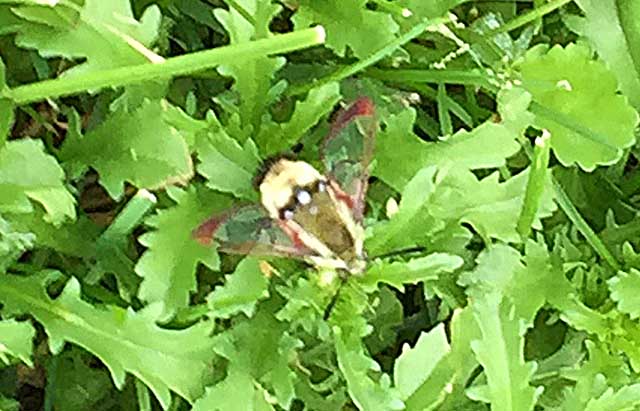
Hemaris thetis, Whitefish, Flathead County, Montana,
May 31, 2018, courtesy of Richard Kurth.
Note the rusty color near the wing-roots. This species tends to be slightly smaller than the very similar Hemaris diffinis.
Visit Hemaris thetis, Gabriola Island, British Columbia, Canada, June 28, 2008, courtesy of Jean Wyenberg.
Visit Hemaris thetis, Mt. Hamilton, Santa Clara County, California, May 20, 2009, Owen Holt.
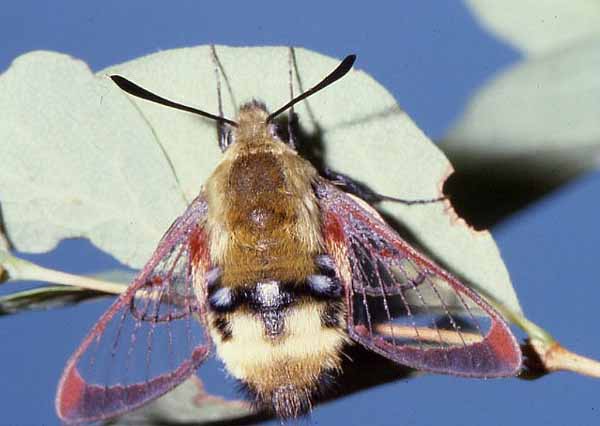
Hemaris thetis, from southern British Columbia,
courtesy
of Jeremy B. Tatum and Dr. John Snyder.
Hemaris thetis is a very variable species, but almost always the abdomen sports contrasting black and yellow hairs, the ventral surface being quite black. The legs also tend to be quite dark and there is a black mask running across the eye and along the sides of the thorax.
Adults mimic bumblebees and are quite variable, both geographically and seasonally. The wings are basically clear, with dark brown to brownish-orange veins, bases and edges. The thorax is golden-brown to dark greenish-brown. The abdomen tends to be dark (black) with 1-2 yellow segments just before the terminal end. These yellow segments are in much sharper contrast to the rest of the abdomen than in somewhat similar species. Also note the relatively narrow dark outer margin of the hindwing. Most fresh specimens also have some blue "fur" tufts highlighting the first black band on the abdomen.
The dorsal surfaces of the legs in Hemaris thysbe are whitish-pale grey, and the legs of Hemaris gracilis are red.
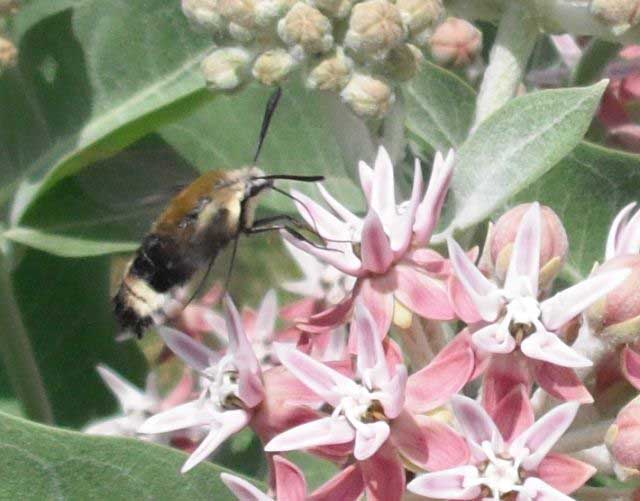
Hemaris thetis necaring at milkweed, Wolf Creek, Josephine Co., Oregon,
June 11, 2009, courtesy of Edna Woodward.
Larvae pupate in thin walled cocoons under leaf litter.
David Wikle obtained eggs from a female, in San Jacinto Mountains, Riverside Co. California, above Lake Hemet on June 24, 2007. His image of an egg is to the right.David indicates pupation began on July 15-16 so progress was quite rapid. His images of first instars and second instar, are below. David also indicates the species, is flying on Mt Baldy in the San Gabriel Mountains, San Bernardino Co., California on July 11, 2009. Moths are expected in nine days to two weeks. |
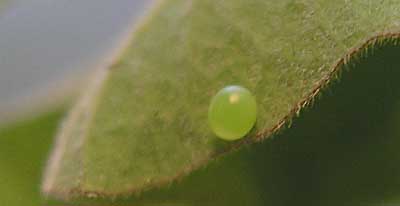 |
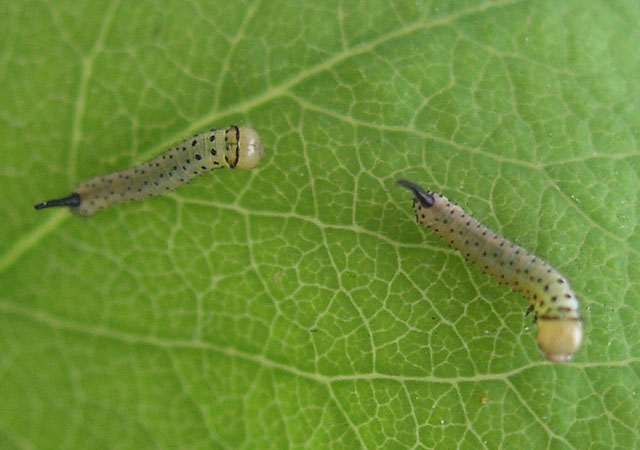
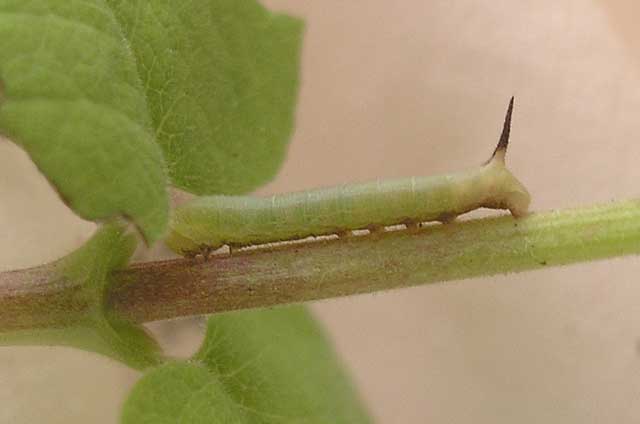
Edna Woodward sends the following images of various instars.
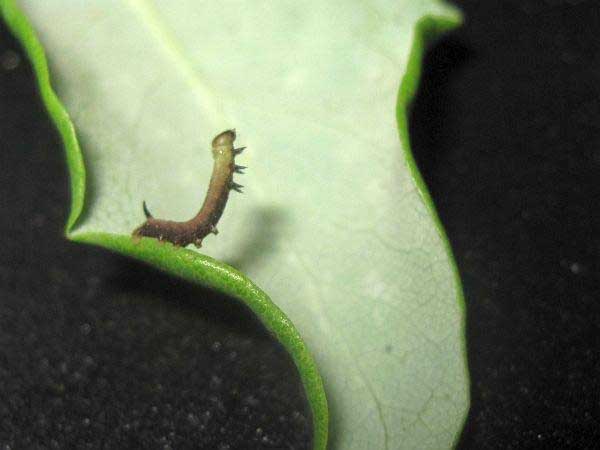
Hemaris thetis, first or second instar?, Wolf Creek, Josephine County, Oregon,
June 30, 2011, courtesy of Edna Woodward.
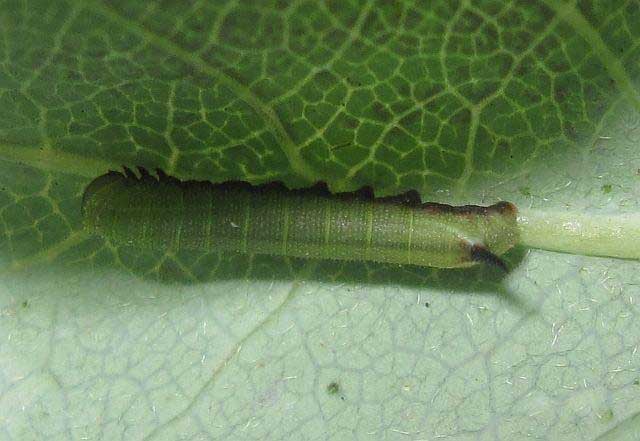
Hemaris thetis, second or third instar?, Wolf Creek, Josephine County, Oregon,
July 2, 2011, courtesy of Edna Woodward.
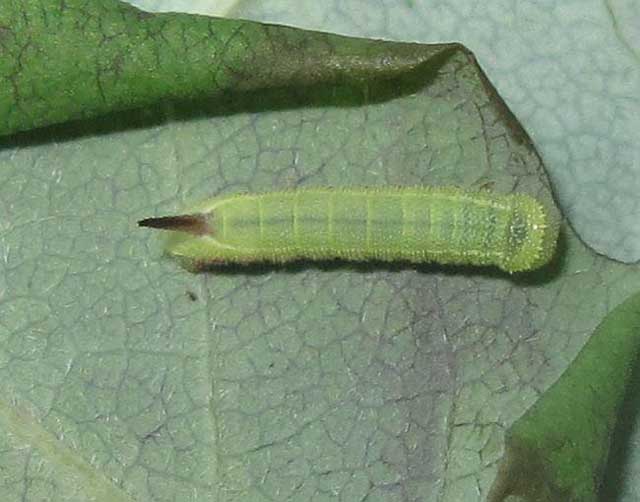
Hemaris thetis, second or third instar?, Wolf Creek, Josephine County, Oregon,
July 4, 2011, courtesy of Edna Woodward.
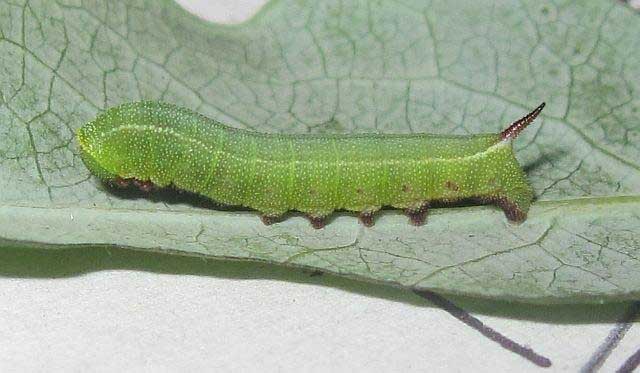
Hemaris thetis, second or third instar?, Wolf Creek, Josephine County, Oregon,
July 5, 2011, courtesy of Edna Woodward.
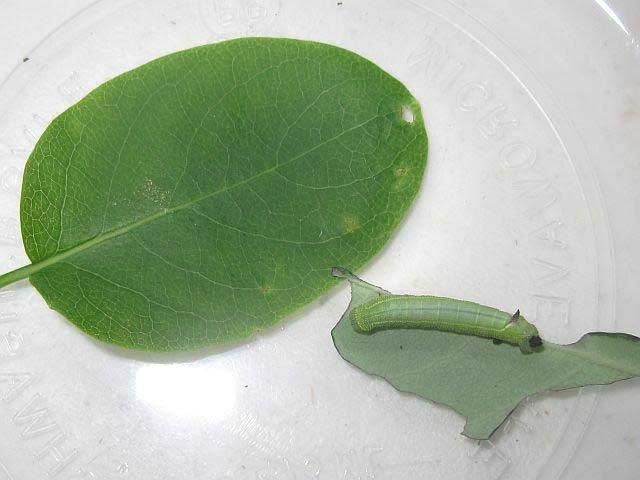
Hemaris thetis on wild honeysuckle, Wolf Creek, Josephine County, Oregon,
courtesy of Edna Woodward.
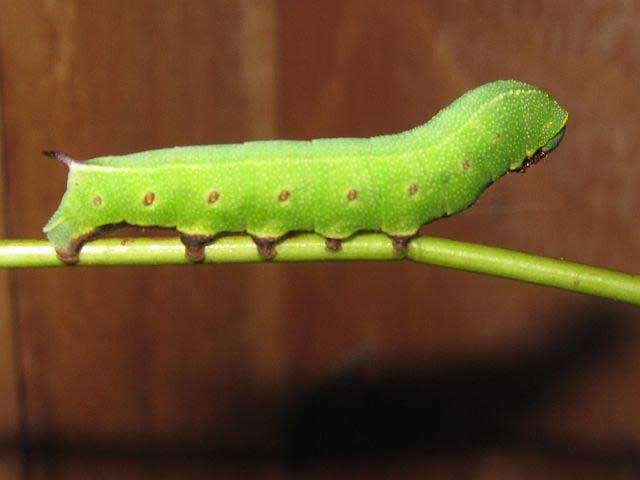
Hemaris thetis, fourth instar?, Wolf Creek, Josephine County, Oregon,
July 15, 2011, courtesy of Edna Woodward.
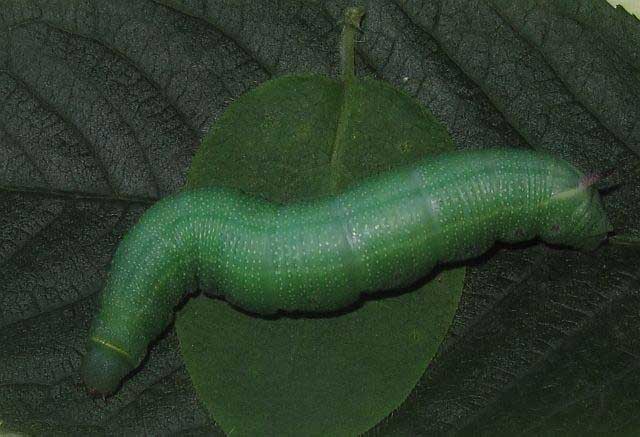
Hemaris thetis, final instar, Wolf Creek, Josephine County, Oregon,
July 22, 2011, courtesy of Edna Woodward.

Hemaris thetis, prepupal, Wolf Creek, Josephine County, Oregon,
July 30, 2011, courtesy of Edna Woodward.

Hemaris thetis, fresh pupa (will darken shortly), Wolf Creek, Josephine County, Oregon,
July 30, 2011, courtesy of Edna Woodward.
"I never saw a single change of instar, nor a sign of a shed skin, and I had it sitting right beside me the whole time, looked at it off and on all day every day.
"On July 22, he was fully grown, and by the next morning he was storming around his house like a bear with a sore butt. He would flop around wildy if I went near him. I put him in the quiet room and this am (July 28, without any color change) he is sitting very still on top of the paper towels and has sweated much, so I expect he will pupate soon."
I suspect larvae of this species eat their discarded skins right after molting, otherwise Edna, who is very observant, would have seen them. She reared the found larva on wild honeysuckle.
Edna has also directed me to another webpage where there is documentation of an Hemaris thysbe larva promptly turning to devour the exuvia after molting, so this may be a common practice with Hemaris species.
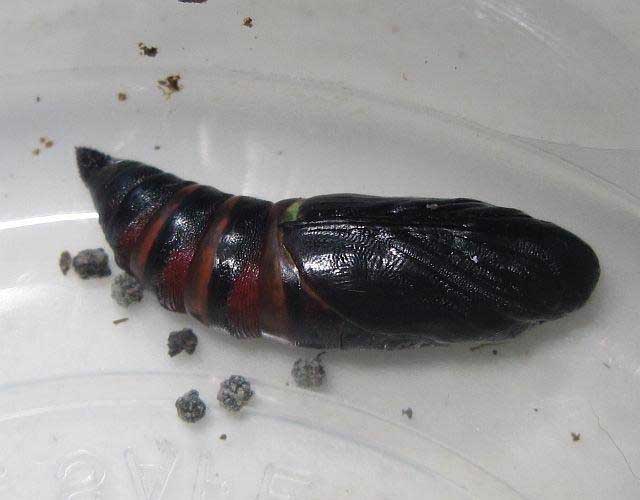
Hemaris thetis, hardened pupa, Wolf Creek, Josephine County, Oregon,
August 1, 2011, courtesy of Edna Woodward.
Larval host plants include Snowberry (Symphoricarpos), honeysuckle (Lonicera), Coralberry, viburnums, low-bush cranberry and hawthorn..
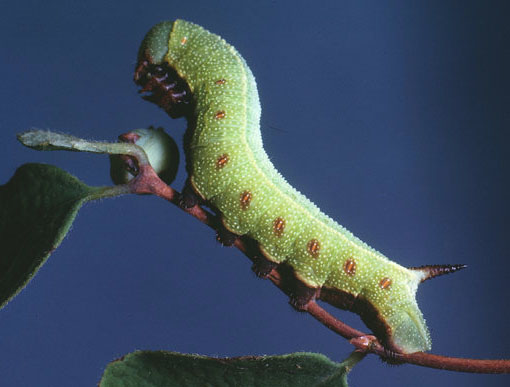
Hemaris thetis, British Columbia, courtesy of G. A. Hardy
Larvae can vary, but in most cases the final instar has a long black anal horn, lighter or yellow near the base. Spiracular circles tend to be very large, prominent and black, but there are regional differences. Western species (H. thetis) often have a shorter, thicker horn and much smaller and lighter spiracular circles as compared to the very similar eastern species H. diffinis.
Green colouration of larvae is typical, but just before pupation larvae often darken to purplish-brown.
Use your browser "Back" button to return to the previus page.
Those who first published descriptions and
assigned scientific names to many insects, simply chose names of
biblical or mythological origin without any real descriptive
qualities. Their purpose was simply to set a standard for purposes
of identification by assigned name. On some occasions, names,
mostly of Latin or Greek origin, were chosen to signify a particular
character of the genus or of an individual species.
The genus name "Hemaris" is probably a Latin adjective form for
blood. It may have been chosen by Dalman based on the burgundy-red
scales on the wings.
The original choice of "Macroglossa" would have been for the
relatively large, glassy (clear) areas of the wings.
In ancient Greek Mythology "thetis" is the silver-footed sea nymph.
The pronunciation of scientific names is
troublesome for many. The "suggestion" at the top of the page is
merely a suggestion. It is based on commonly
accepted English pronunciation of Greek names and/or some
fairly well accepted "rules" for latinized scientific names.
The suggested pronunciations, on this page and on other pages,
are primarily put forward to assist those who hear with internal
ears as they read.
There are many collectors from different countries whose
intonations and accents would be different.
Return to Sphingidae Index
Return to Dilophonotini Tribe
Return to Hemaris Genus
Enjoy some of nature's wonderments, giant silk moth cocoons. These cocoons are for sale winter and fall. Beautiful Saturniidae moths will emerge the following spring and summer. Read Actias luna rearing article. Additional online help available.
Use your browser "Back" button to return to the previous page.
This page is brought to you by Bill Oehlke and the WLSS. Pages are on space rented from Bizland. If you would like to become a "Patron of the Sphingidae Site", contact Bill.
Please send sightings/images to Bill. I will do my best to respond to requests for identification help.
 Show appreciation for this site by clicking on flashing butterfly to the left. The link will take you to a page with links to many insect sites. |